traction control AUDI A6 2014 Owners Manual
[x] Cancel search | Manufacturer: AUDI, Model Year: 2014, Model line: A6, Model: AUDI A6 2014Pages: 304, PDF Size: 76.32 MB
Page 109 of 304
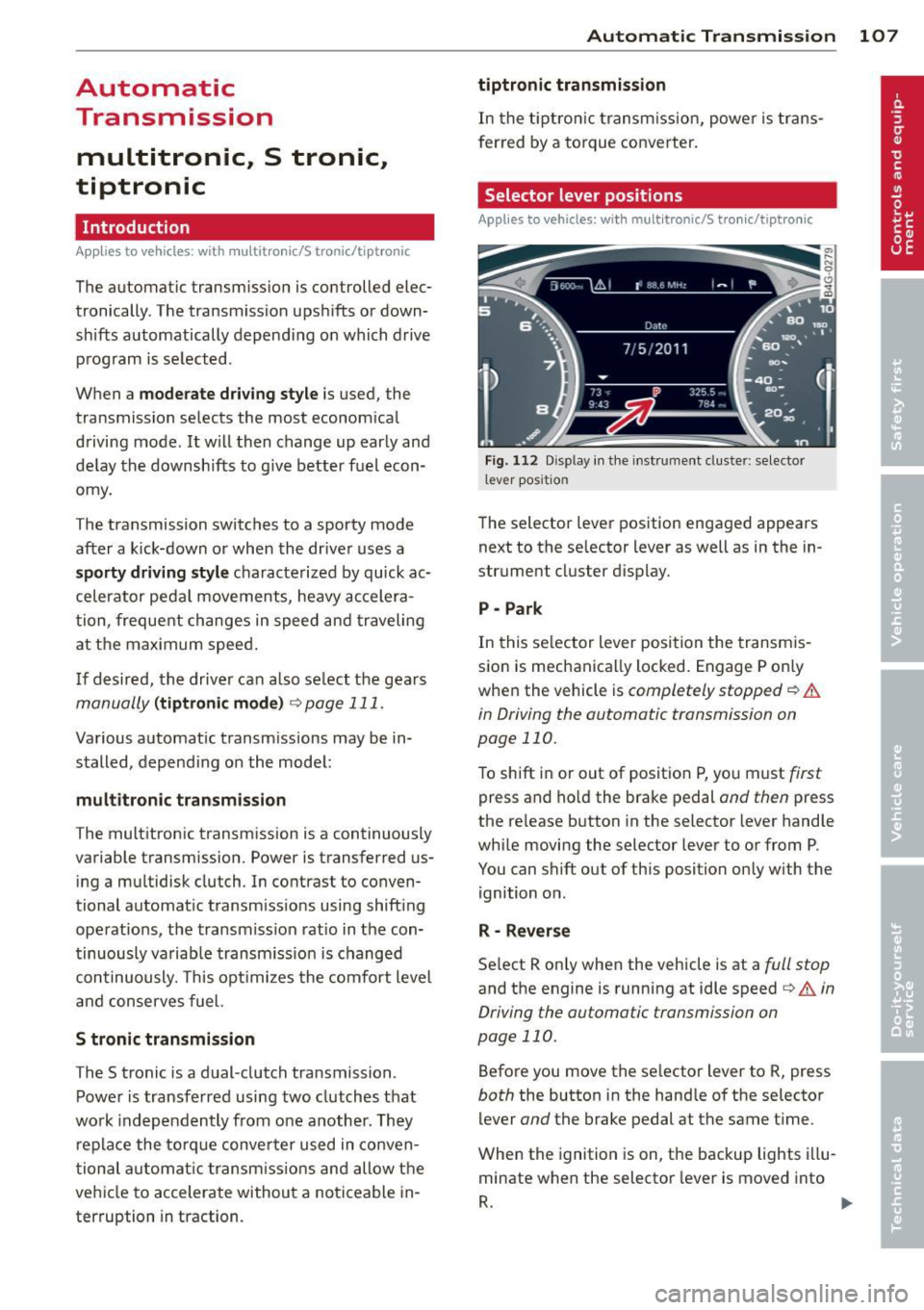
Automatic Transmission
multitronic, S tronic,
tiptronic
Introduction
App lies to vehicles: with multit ro nic/S tronic/t ipt ronic
The automat ic transm iss ion is controlled elec
tronically . The transmiss ion ups hifts or down
shifts automatically depend ing o n which drive
p rog ram is se lect ed.
When a
moderate driving style is used, the
tra nsmission selects the most econom ica l
d riving mode .
It will then change up early and
de lay the downshifts to g ive bette r fu el econ
omy.
The transmission switches to a sporty mode after a k ick- down or when the drive r uses a
sporty driving style ch aracte rized by quick ac
celerator peda l movements, heavy ac celera
tion, frequent ch anges in speed and traveling
at the maximum spee d.
I f desired, the drive r can a lso se lect the gears
manually ( tiptronic mode ) ¢ page 111.
Various automat ic transm issions may be in
stalled, depend ing o n the mode l:
multitronic transmi ssion
The mult itron ic transm ission is a continuously
variable transmission. Power is transferred us i n g a mu ltidisk clutch . In contrast to conven
tional automat ic transm iss ions using shift ing
ope rations, the transmiss ion ratio in the con
tinuously va riab le transm iss io n is changed
con tinuously. Th is op timi zes the com fort level
a nd co nserves fuel.
S tronic transmission
The S tronic is a dual -clutch transmission .
P owe r is transfe rred using two clutches that
wo rk ind ependen tly from one a nother. They
r e pl ace the tor qu e conve rter u sed in co nven
tional a utoma tic transm iss io ns an d allow t he
ve hicl e to accelerate without a no ticeable in
ter ruption in traction.
Automatic Transmission 107
tiptronic transmission
In the tipt ronic t ra nsm issio n, p ower is trans
f erred by a to rque converter .
Selector lever positions
Applies to vehicles: wit h mult itronic/5 tro nic/tiptro nic
Fig . 1 12 Disp lay in th e inst rume nt cluster: selector
l ever pos itio n
The selector leve r pos ition engaged appears
next to the se lector lever as well as in the in
strument cluster d isp lay.
P -Park
In this se lector lever posi tion the transm is
s io n is mechanica lly locked. Engage P on ly
whe n the vehicle is
completely stopped¢&.
in Driving the automatic transmission on
page 110.
T o sh ift i n or out of posit io n P, you must first
press and ho ld the brake pedal and then press
the re lease b utton in the selector lever hand le
whi le moving the selector lever to or from P .
You can shift out of th is position only with the
ignition o n.
R -Reverse
Se lect R on ly when the vehicle is at a full stop
and the engine is running at idle speed¢ A in
Driving the automatic transmission on
page 110 .
Before you move the se lector lever to R, press
both the button in the hand le o f the selecto r
lever
and the brake pedal at the same t ime .
When the ignition is on, the backup lights illu
m inate when the selecto r lever is moved into
R. .,.
Page 197 of 304
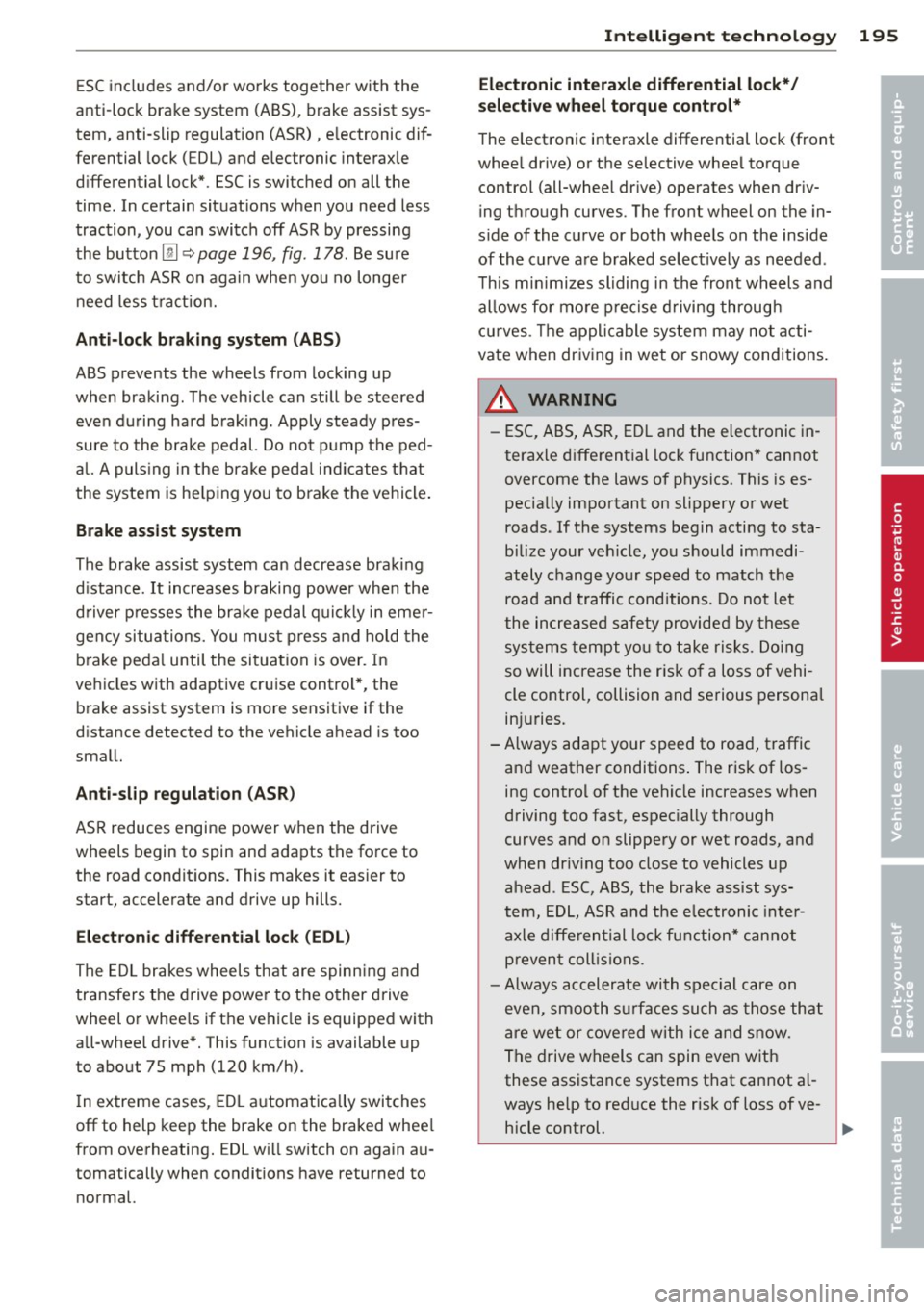
ESC includes and/or works together with the
anti-lock brake system (ABS) , brake assist sys
tem, anti -slip regulation (ASR) , e lectronic dif
ferential lock ( EDL) and e lectronic interax le
d ifferential lock* . ESC is swi tched on all the
time. In certain situat ions when you need less
traction , you can switch off ASR by pressing
the button
[ru <::;> page 196, fig . 178 . Be sure
to switch ASR on again when you no longer
n eed less t raction.
Anti-lock br aking s ystem (ABS)
ABS prevents the wheels from locking up
when braking . The veh icle can still be steered
even during hard braking . Apply steady pres
sure to the brake pedal. Do not pump the ped
a l. A puls ing in the bra ke peda l indicates that
the system is he lping you to brake the vehicle.
Brake assist system
The brake assist system can decrease brak ing
d istance.
It increases braking power when the
driver p resses the brake pedal quic kly in emer
gency situations. You must press and ho ld the
b rake peda l until the situation is over . In
vehicles with adaptive cruise control* , the
brake assist system is more sensitive if the
d istance detected to the vehicle ahead is too
small.
Anti -slip regulation (ASR )
ASR reduces engine power when the d rive
wheels begin to spin and adapts the force to
the road condit ions. This makes it eas ie r to
s tart, accelerate and drive up hills.
El ectronic diffe rential lock (EDL )
The ED L brakes wheels that are spinn ing and
transfers the drive powe r to the other drive
wheel or whee ls if the vehicle is equipped with
all-whee l drive*. This function is available up
t o about 75 mph (120 km/h).
I n extreme cases , ED L automatica lly switches
off to help keep the brake on the braked whee l
from overheating.
E DL wi ll switch on again au
tomatically when conditions have returned to normal.
Int ellig ent technolog y 195
Electronic intera xle differential l ock */
se le ctive wheel torque cont rol *
The electronic interaxle differential lock (front
whee l drive) or the se lective whee l torque
cont rol (all-wheel dr ive) operates when dr iv
ing through curves . The front wheel on the in
s ide of the curve or both wheels on the inside
of the curve are braked selectively as needed .
T his min imizes sliding in the front wheels and
allows for more p recise d riving through
curves . T he applicable system may no t acti
vate when driv ing in wet or snowy conditions.
A WARNING
-- ESC, ABS, ASR, EDL and the electronic in
teraxle diffe rential lock function* cannot
overcome the laws of physics. This is es
pecially important on slippery or wet
roads . If the systems begin acting to sta
bilize your veh icle, you should immedi
ately change yo ur speed to match the
road and traffic cond itions. Do not let
the increased safety provided by these
systems tempt you to take risks. Do ing
so will increase the r isk o f a loss of vehi
cle control, collision and serious personal inju ries.
-Always adapt your speed to road, traffic and weather conditions . The risk of los
ing control of the vehicle increases when
driving too fast, espec ially through
curves and on slippery or wet roads, and
when dr iv ing too close to vehicles up
ahead . ESC, ABS, the brake assist sys
tem, EDL, ASR and the e lectronic inte r
axle d iffe ren tial lock function* cannot
preven t coll is ions.
- Always accelerate with spec ial care on
even, smooth surfaces su ch as those that
are wet or covered with ice and snow.
The drive wheels can spin even with
these assistance systems that cannot al
ways he lp to red uce the risk of loss of ve-
hicle control. .,.
•
•
Page 201 of 304
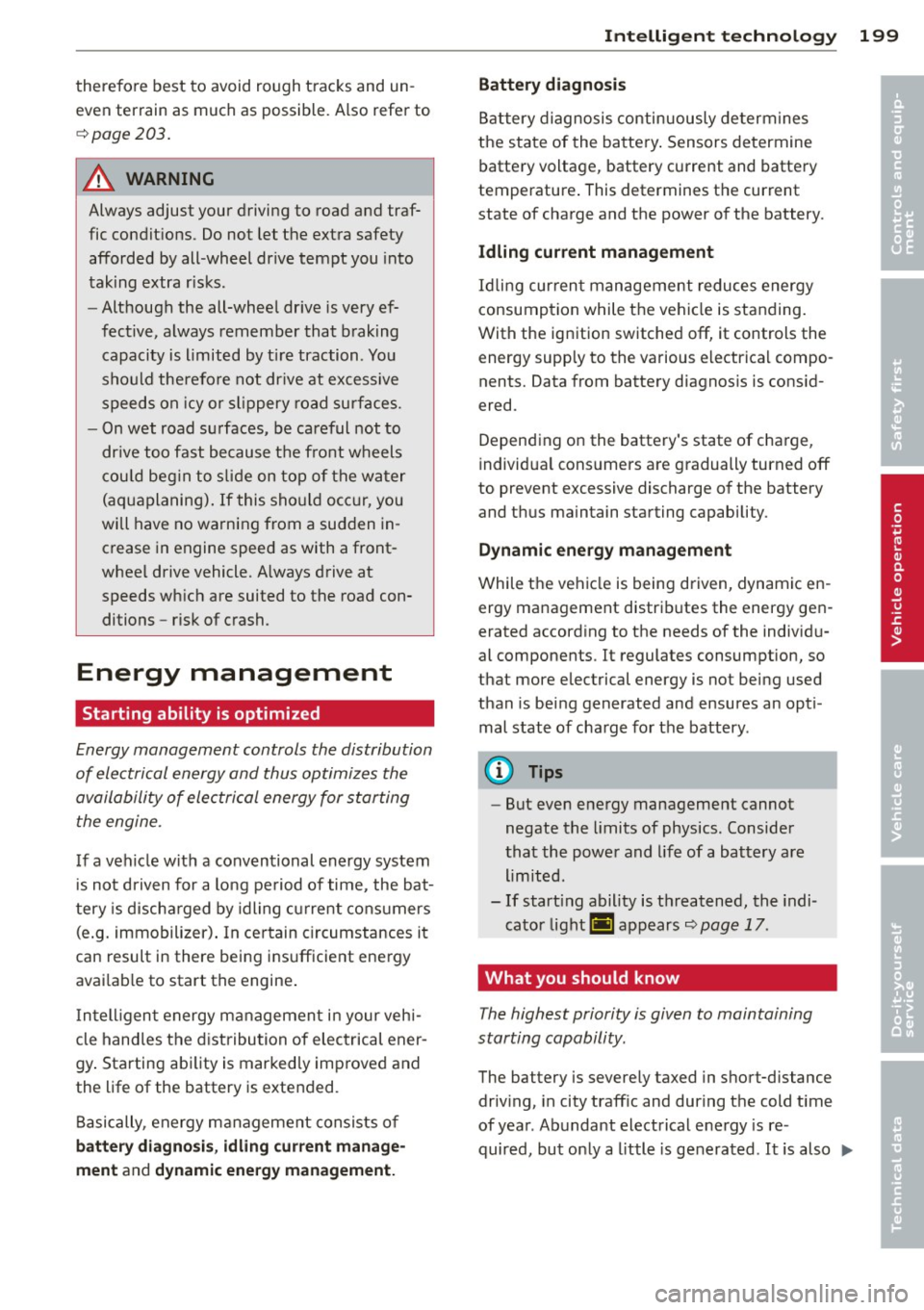
therefore best to avoid rough tracks and un
even terrain as much as possible . Also refer to
<=:> page 203.
A WARNING
Always adjust your driving to road and traf
fic conditions. Do not let the extra safety
afforded by all-wheel dr ive tempt you into
taking extra risks.
- Although the all-wheel dr ive is very ef
fective, a lways remember that braking
capacity is limited by t ire traction . Yo u
should therefore not dr ive at excessive
speeds on icy or slippery road su rfaces.
- On wet road su rfaces, be careful not to
dr ive too fast because t he fro nt wheels
c ou ld beg in to s lide on top of the wa ter
(aq uaplaning). If this sho uld occ ur, you
will have no warning from a sudden in
crease in engine speed as with a front
wheel drive vehicle. A lways drive at
speeds wh ich are suited to the road con
ditions -risk of crash.
Energy management
Starting ability is optimized
Energy management controls the distribution
of electrical energy and thus optimi zes the
availability of electrical energy for starting the engine .
If a veh icle wit h a conventional energy system
i s not d riven for a lo ng pe riod o f time, the bat
tery is discha rged by idling cu rrent co nsu mers
(e .g. immobilizer) . In ce rtain c ircumstances it
can result in there being insufficient ene rgy
avai lab le to start the engine .
I n tell igen t energy m anagemen t in your veh i
cle hand les the d istribu tion of electrical ener
gy . Starting ab ility is marked ly imp roved and
the life of the battery is extended.
B asically , energy management consists o f
battery diagnos is , idling current manage
ment
and dynamic ene rgy man agement.
Int ellig ent technolog y 199
Battery diagnosis
Battery diagnosis continuously de termines
the state of the battery . Sensors de termine
batte ry voltage, battery current and battery
temperature . This determines the current
state of charge and the power of the battery.
Idling current management
Idling curren t management reduces energy
consumption while the vehi cle is standing.
With the ignition switched off, it controls the
energy supply to the various electrica l compo
nents. Data from battery diagnos is is cons id
ered .
Depending on the battery's state of charge,
i ndivid ua l cons umers are g radually turned off
to prevent excessive discharge of the battery
and thus maintain starting capability .
Dynamic energy management
While the vehicle is being driven, dynamic en
ergy ma nagement distrib utes the energy ge n
erated accord ing to the needs of the individ u
al components . It regulates consum ption, so
that more electrical energy is not being used
than is being generated and ensures an opti
mal state of cha rge for the battery .
(D Tips
-But even ene rgy management cannot
negate the limits of physics. Consider
t hat the powe r and life of a battery are
limited .
- If start ing ability is threatened , the indi
cator light (•) appears
c::> page 17 .
What you should know
The highest priority is given to maintaining
starting capability.
The battery is severely taxed in short-distance
driv ing, in city traff ic and during the cold time
of year . Abundant electrical energy is re -
quired, but on ly a little is generated . It is also ..,. •
•
Page 253 of 304
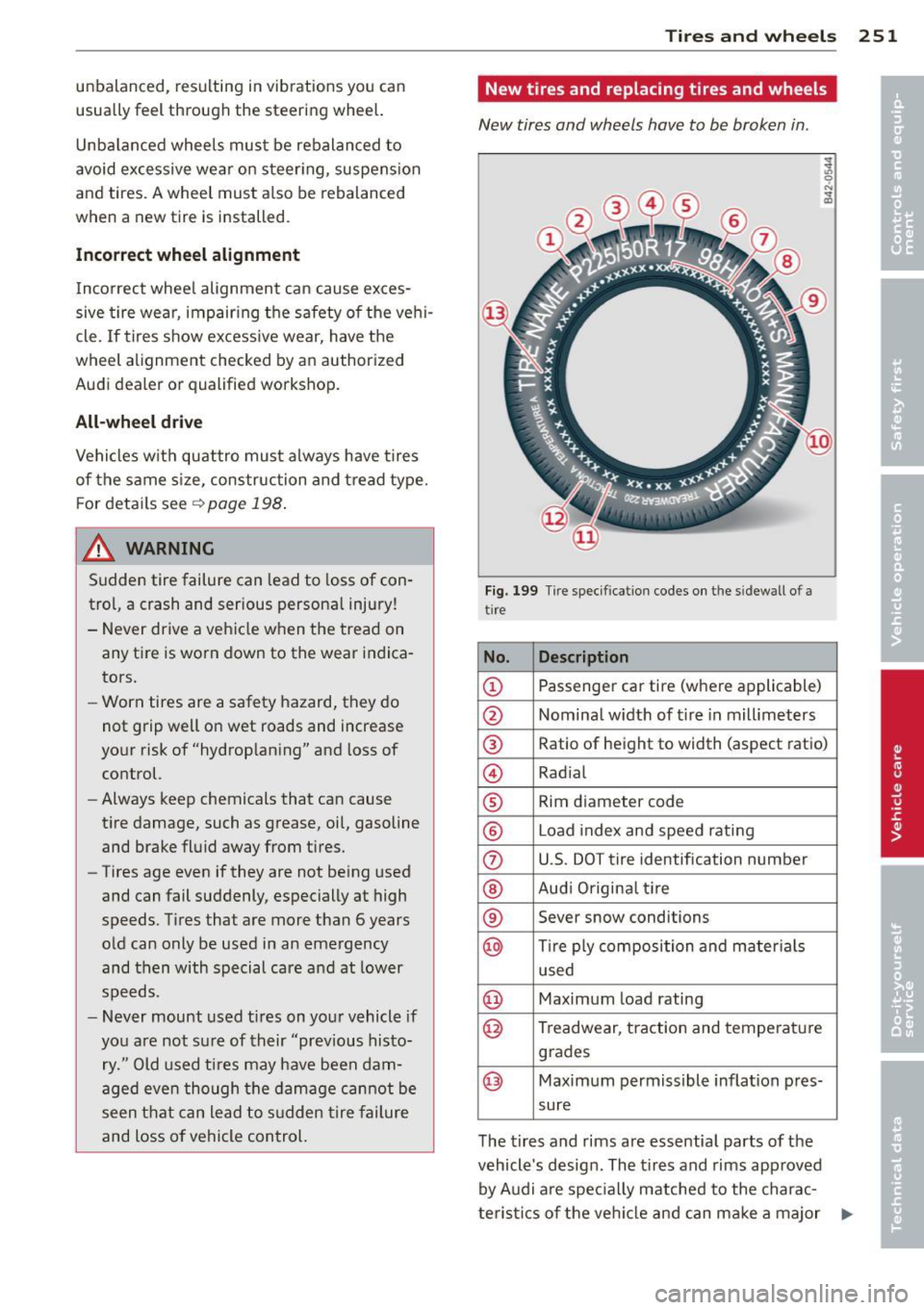
unbalanced, resulting in vib rations you can
usually feel through the steering wheel.
Unba lanced wheels mus t be rebalanced to
avoid excessive wea r on s teer ing, suspens ion
and tires. A wheel must a lso be rebalanced
when a new tire is installed.
Incorrect wheel alignment
Inco rrect whee l alignment can cause exces
sive tire wea r, impair ing t he safety of the veh i
cle. If t ires show excess ive wear, have the
wheel alignment checked by an authorized
Audi dealer or qualified workshop.
All-wheel d rive
Ve hicles w it h quattro must always have tires
of the s ame s ize, construction and tread type.
F or detai ls see
¢ page 198 .
A WARNING
Sudden tire failure can lead to loss of con
trol, a crash and serious persona l injury!
- Never drive a veh icle when the tread on
any t ire is worn down to the wear indica
tors.
- Worn tires are a safety hazard , they do
not grip well on wet roads and increase
your risk of"hydrop lan ing" and loss of
co ntrol.
- Always keep chemicals that can cause
tire damage, such as grease, oil, gasoline
and brake fluid away from tires.
- Tires age even if they are not being used
and can fail suddenly, especially at high
speeds. Tires that are more than 6 years
old can only be used in an emergency
and then with special care and at lower
sp eeds.
- Never mount used tires on yo ur vehicle if
yo u are not sure of their "previous histo
ry." Old used ti res may have been dam
aged even though the damage cannot be
seen that can lead to s udden tire failure
and loss o f vehicle control.
Tires and wheels 251
New tires and replacing tires and wheels
New tires and wheels have to be broken in.
Fig. 199 Tire spec ification codes on the s idewall of a
tire
No . Description
@ Passenger car tire (where applicable)
@ Nominal w idth of t ire in millimeters
@ Ratio of height to width (aspect ratio)
© Rad ial
® Rim diameter code
® Load index and speed rati ng
0 U.S. DOT tire identification number
® Audi Original tire
® Sever snow conditions
@ Tire ply composition and ma terials
used
@ Maximum load rating
@ Treadwear, traction and tempe rat ure
grades
@ Maximum permissible inflation pres-
sure
T he tires and rims are essential parts of the
vehicle's design . The ti res and rims approved
by Audi a re spec ia lly matched to the charac
teris tics of the ve hicl e and can m ake a major .,.
Page 255 of 304
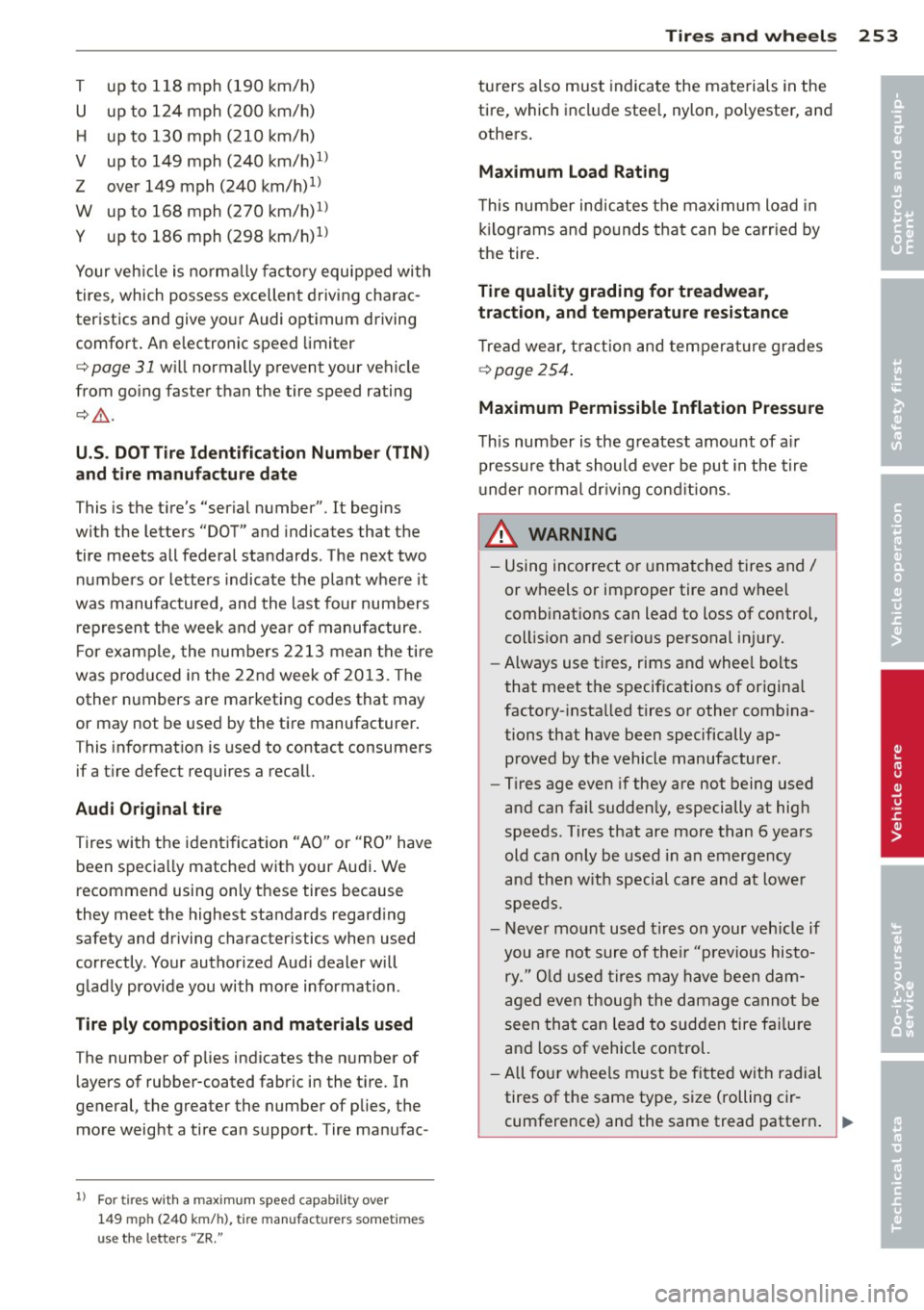
T up to 118 mph (190 km/h)
U up to 124 mph (200 km/ h)
H up to 130 mph (210 km/ h)
V up to 149 mph (240 km/h)1
)
Z over 149 mph (240 km/h)l)
W up to 168 mph (270 km/h)l)
Y up to 186 mph (298 km/h)l)
Your veh icle is no rma lly factory equipped with
tires , which possess excellent driving charac
teristics and give yo ur Audi opt imum driving
comfort . An e lectronic speed limiter
c::> page 31 w ill normally prevent you r vehicle
from go ing faster t han the tire speed ra ting
c:::> .& .
U.S . DOT T ire Id entification Numbe r (TIN )
and tire manufacture date
This is the t ire's "serial number". It begins
with the letters "DOT" and indicates that the
tire meets all federal standards . The next two
numbers or lette rs indicate the plant whe re it
was manufactured, and the last four numbers r ep resent the week and year of manufacture.
F or
examp le, the numbers 22 13 mean the ti re
was pro duced in the 2 2nd week of 2013. The
other numbers are marketing codes that may
or may not be used by the ti re manufacturer .
T his in format ion is used to contact consumers
if a t ire defect requires a reca ll.
Aud i Original tir e
Tires with t he ident ificat ion "AO" or "RO" have
been specia lly matched with your Audi . We
recommend using only these tires because
they meet the highest standards regard ing
safety and driving character istics when used
correctly . Your authorized Audi dealer will
g ladly provide you with more information .
Tire ply composit ion and materials u sed
T he number of plies ind icates the n umber of
layers of rubber-coated fabric in the t ire. In
general, the greater the number o f plies, the
more weig ht a tire can support. Tire manufac -
llFt· "h · or ires wit a m ax im um spee d ca pabil ity over
1 4 9 mp h (24 0 k m/h) , tire ma nufa ctur ers somet ime s
use th e let ters "Z R."
Tire s an d wheel s 253
ture rs also must indicate the mate rials in the
ti re, which incl ude stee l, nylon, po lyester, and
others .
Maximum Load Rating
This number ind icates the maximum load in
k ilograms and po unds that can be ca rr ied by
the tire.
Tire quality grading for treadwear,
traction, and temperature resistance
T re ad wear, t raction and tempera ture grades
c::> page 2 54 .
Maximum Permissible Inflation Pressure
This number is the greatest amount of a ir
pressure tha t should ever be pu t in the t ire
u nder norma l dr iv ing cond itions .
_&. WARNING ,-=
-Using incorrect o r unmatched tires and/
or wheels or improper tire and wheel
comb inatio ns can lead to loss of control
'
coll is ion and serious personal inj ury.
- Always use ti res, rims and whee l bolts
that meet the specifications of original
factory- insta lled tires or other combina
tions that have been specifically ap proved by the vehicle manufacturer.
- Tires age even if they are not being used
a nd can fai l sudden ly , especially at hig h
speeds . Tires that are more than 6 years
old can only be used in an emergency
a nd then w ith specia l care and at lower
speeds.
- Never mo unt used tires on your veh icle if
you are not sure of the ir "previous histo
ry." O ld used tires may have been dam
aged even though the damage cannot be
seen that can lead to sudden tire fai lure
and loss of vehicle control.
- All fou r whee ls must be fitte d wit h radial
tires of the same type, size (rolling cir
cumference) an d the same tread pattern .
~
•
•
Page 256 of 304
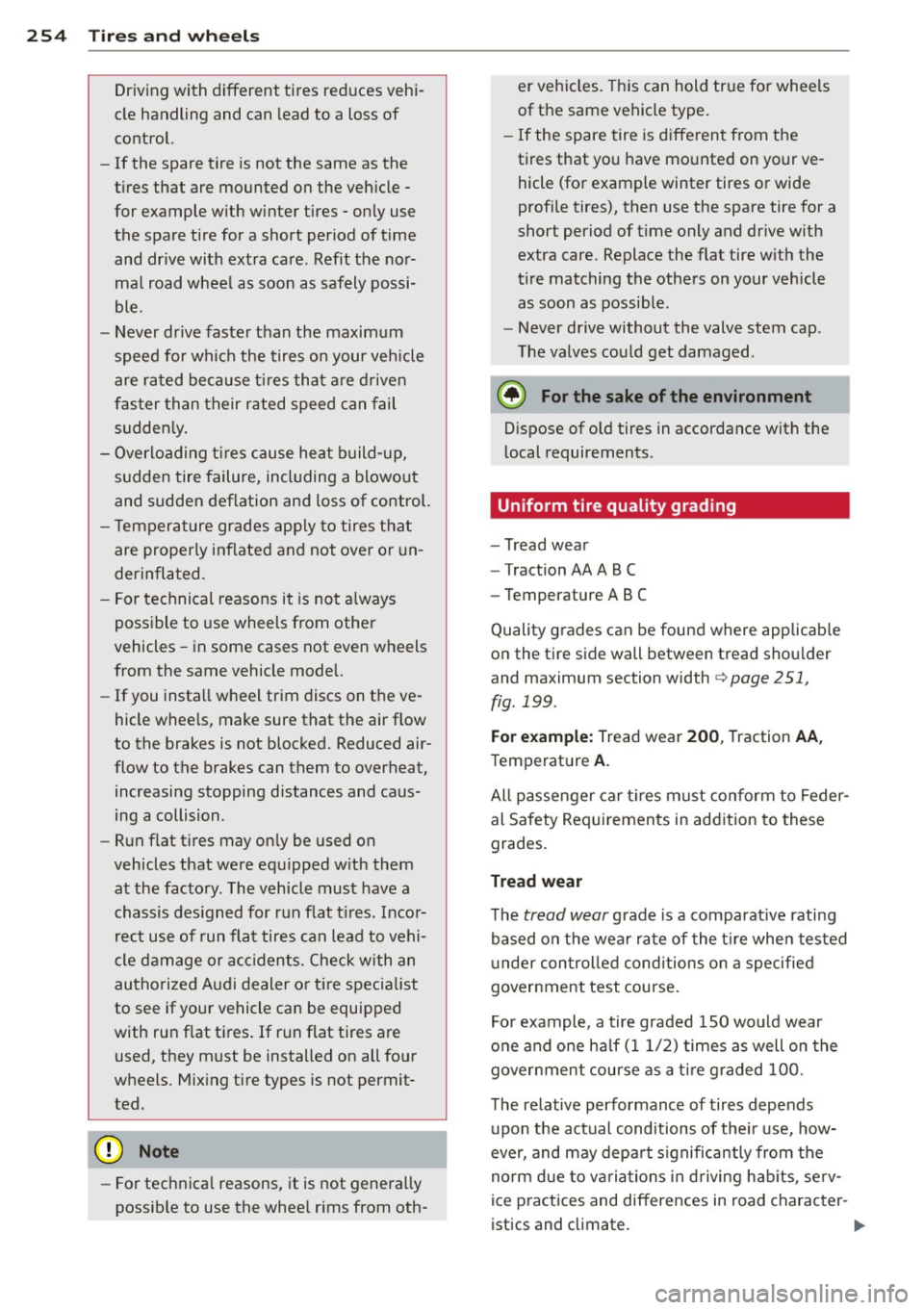
254 Tires and wheels
Driving with different tires reduces vehi
cle handling and can lead to a loss of
control.
- I f the spare tire is not the same as the
tires that are mounted on the vehicle -
for example with winter tires - only use
the spare tire for a short period of time
and drive with extra care . Refit the nor
mal road wheel as soon as safely possi
ble.
- Never drive faster than the maximum
speed for which the tires on your vehicle
are rated because tires that are driven
faster than their rated speed can fail
suddenly.
- Overloading tires cause heat build-up,
sudden tire failure, including a blowout
and sudden deflation and loss of control.
- Temperature grades apply to tires that
are properly inflated and not over or un
derinflated .
- For technical reasons it is not always
possible to use wheels from other
vehicles -in some cases not even wheels
from the same vehicle model.
- If you install wheel trim discs on the ve
hicle wheels, make sure that the air flow
to the brakes is not blocked. Reduced air
flow to the brakes can them to overheat, increasing stopping distances and caus
ing a collision .
- Run flat tires may only be used on
vehicles that were equipped with them
at the factory . The vehicle must have a
chassis designed for run flat tires . Incor
rect use of run flat tires can lead to vehi
cle damage or accidents. Check with an
authorized Audi dealer or tire specialist
to see if your vehicle can be equipped
with run flat tires. If run flat tires are
used, they must be installed on all four
wheels . Mixing tire types is not permit
ted .
(D Note
-For technical reasons, it is not generally
possible to use the wheel rims from oth- er vehicles.
This can hold true for wheels
of the same vehicle type.
- If the spare tire is different from the
tires that you have mounted on your ve
hicle (for example winter tires or wide
profile tires), then use the spare tire for a
short period of time only and drive with
extra care. Replace the flat tire with the
tire matching the others on your vehicle
as soon as possible .
- Never drive without the valve stem cap .
The valves could get damaged .
® For the sake of the environment
Dispose of old tires in accordance with the
local requirements.
Uniform tire quality grading
-Tread wear
- Traction AA A B C
- Tempe ra ture ABC
Quality grades can be found where applicable
on the tire side wall between tread should er
and maximum section width
c;, page 251,
fig. 199.
For example:
Tread wear 200, Traction AA,
Temperature A.
All passenger car tires must conform to Feder
al Safety Requirements in addition to these
grades.
Tread wear
The tread wear grade is a comparative rating
based on the wear rate of the tire when tested
under controlled conditions on a specified
government test course.
For example, a tire graded 1S0 would wear
one and one half (11/2) times as well on the
government course as a tire graded 100.
The relative performance of tires depends upon the actual conditions of their use, how
ever, and may depart significantly from the
norm due to variations in driving habits, serv
ice practices and differences in road character-
istics and climate.
ll-
Page 257 of 304
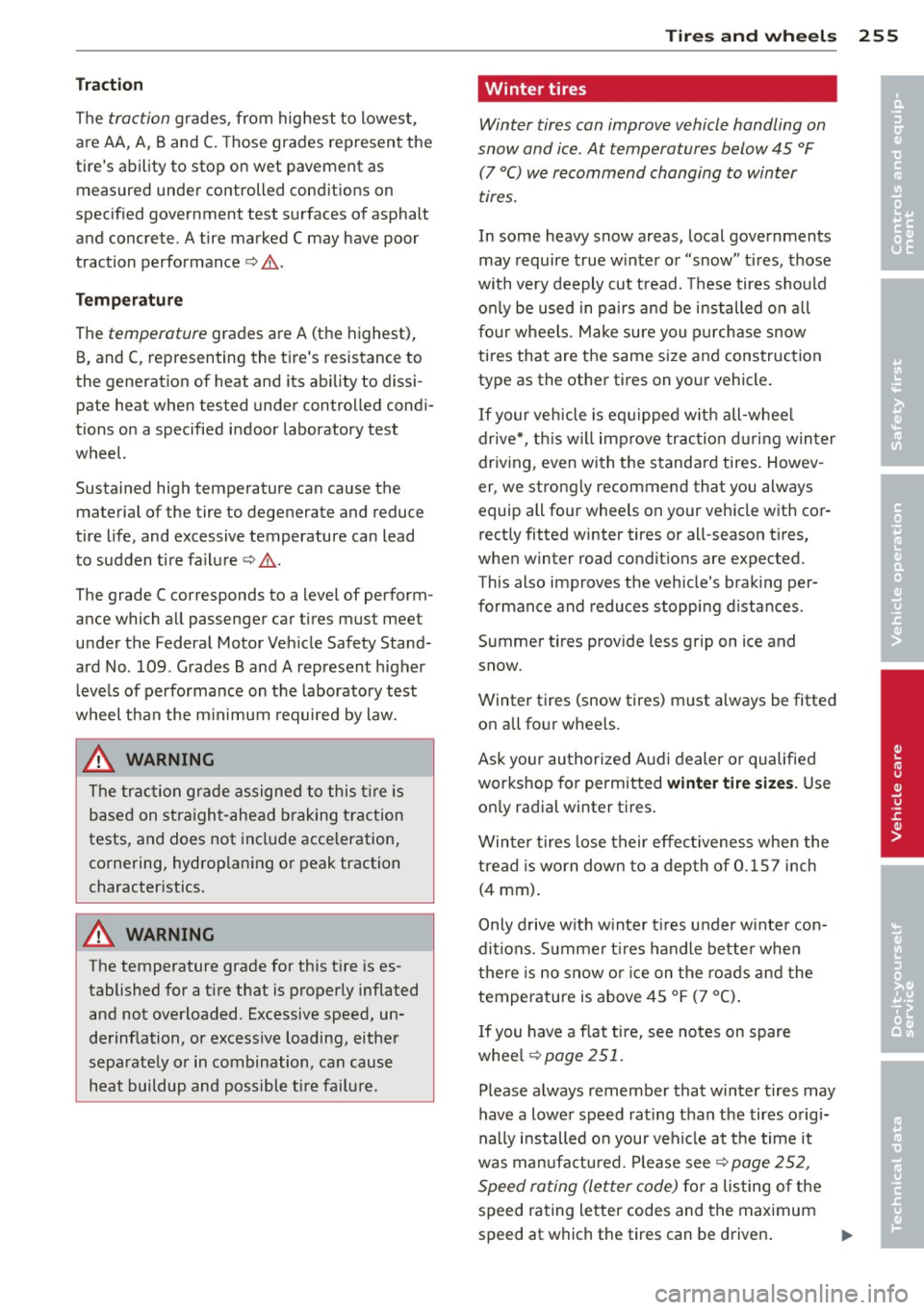
Traction
The traction grades, from highest to lowest,
a re AA, A, Band
C. Those grades represent the
tire's ability to stop on wet pavement as
measured under controlled conditions on
specified government test surfaces of asphalt
and concrete . A tire marked C may have poor
traction performance¢ .&..
Temp eratu re
The temperature grades are A (the highest),
B, and
C, representing the tire 's resistance to
the generat ion of heat and its ability to dissi
pate heat when tested under controlled condi
tions on a specified indoor laboratory test
wheel.
Sustained high temperature can cause the
material of the tire to degenerate and reduce
tire life, and excessive temperature can lead
to sudden tire failu re ¢ .&. .
The grade C corresponds to a level of perform
ance which all passenger car tires m ust meet
u nder the Federa l Motor Ve hicle Safety Stand
ard No.
1 09. Grades Band A represent higher
l eve ls of pe rformance on the laboratory test
wheel than the m inimum required by law.
_& WARNING
Th e traction grade assigned to this tire is
based on stra ight-ahead b raking t raction
tests, and does not include acceleration,
cornering , hydrop laning or peak traction
character istics.
A WARNING
The temperature grade for this t ire is es
tablished for a t ire that is properly inflated
and not overloaded. Excessive speed, un
derinflation, or excessive loading, either
separate ly or in combination, can cause
heat buildup and possibl e tire fa ilu re.
-
Tire s an d wheel s 255
Winter tires
Winter tires can improve vehicle handling on
snow and ice . At temperatures below 45 °F
(7 °C) we recommend changing to winter
tires.
In some heavy snow areas, local governments
may require true w inter o r "snow" tir es, those
with very deeply cut t read. These tires should
o nl y be used in pairs and be installed o n all
f o ur wheels . Make sure you p urchase snow
ti res that are the same size and cons truc tion
type as the other tires on yo ur vehicle .
I f your veh icle is eq uipped w ith all-whee l
drive *, t his w ill improve trac tion durin g w in ter
driv ing, even wi th the s tanda rd tires. Howev
er, we strongly recommend that you always
equip all four wheels on your veh icle w ith cor
rect ly fitted winter tires or all-season t ires,
when winter road condit ions are expected.
This also improves the veh icle 's b rak ing per
fo rmance and reduces stoppi ng d ista nces .
Summer tires provide less grip on ice and
snow.
Winter tires (snow tires) must always be fitted
o n all fo ur whee ls .
As k your au thori zed A udi d ealer or qualified
workshop for permit ted
winter tire size s. Use
o nl y radial winter ti res .
Win ter tires lose their effec tiveness whe n the
tread is worn down to a depth o f
0.15 7 inch
(4 mm) .
Only d rive w it h w inte r tir es under w inte r con
di tions. S umme r tir es handle bette r whe n
t h e re is no s now o r ice on the ro ad s an d the
temperature is above 45 ° F (7 °C) .
I f you have a flat t ire, see notes on spare
whee l
¢page 25 1.
Please a lways remember that winter tires may
have a lowe r sp eed rating than the tires o rig i
nally i nstalled on your veh icle at t he time it
was ma nufactu red. Please see ¢
page 2 52,
Speed ra ting (letter code)
for a lis ting o f th e
speed ra ting lette r codes and the max imum
speed at which the tires can be driven .
111>-
•
•